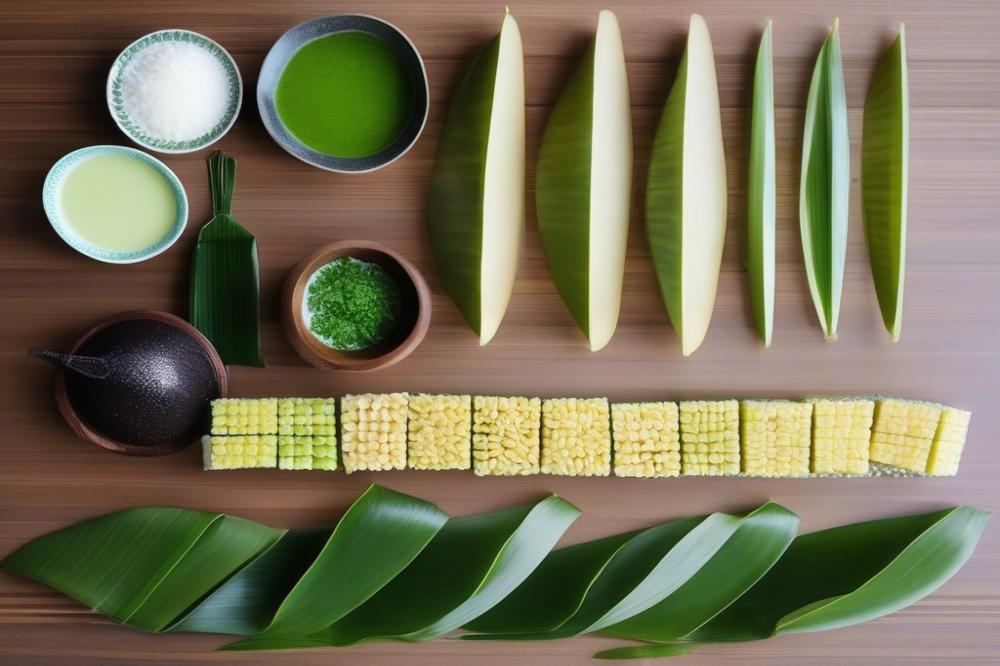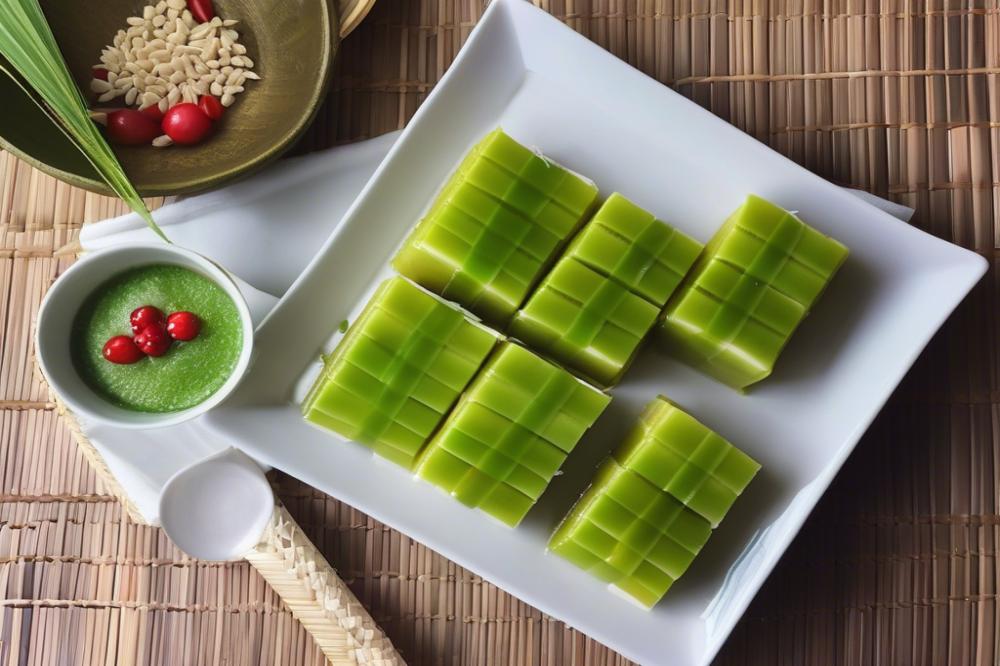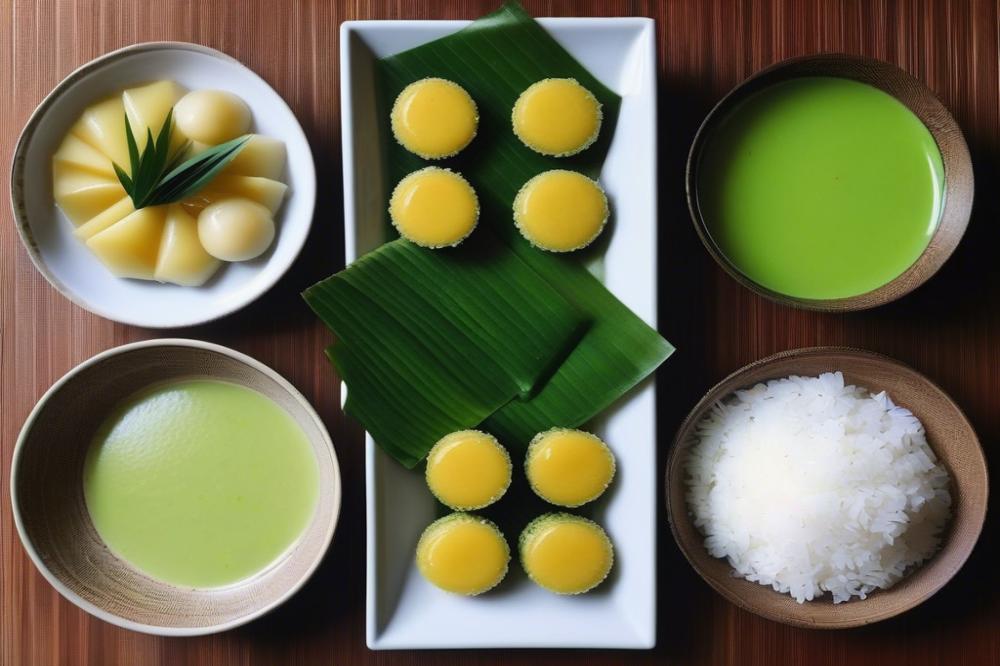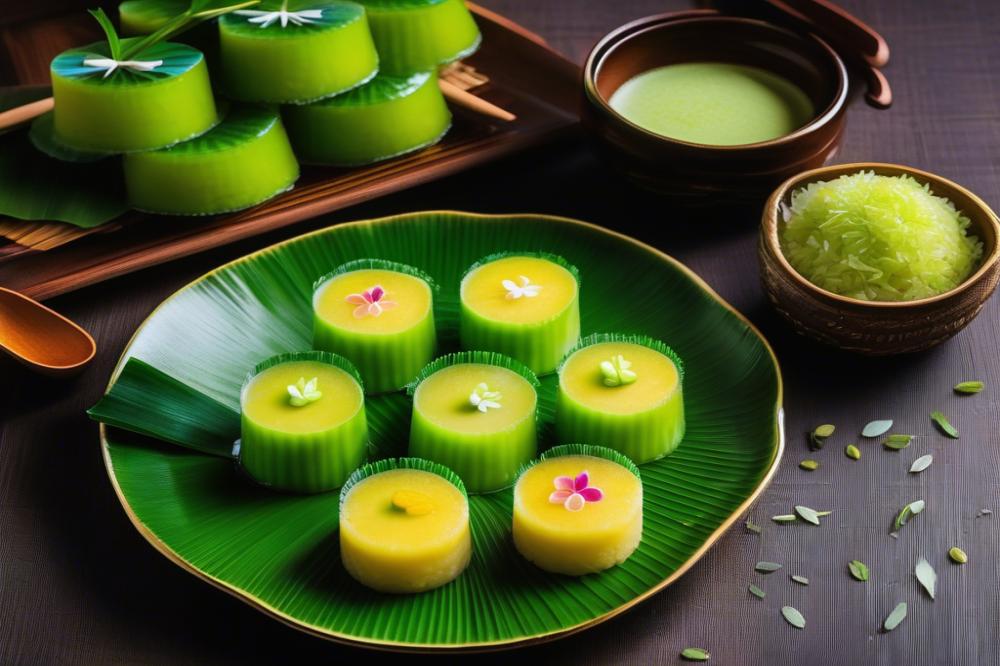Introduction
Kuih Seri Muka stands out as a beloved classic in Malaysian dessert culture. This vibrant steamed cake combines layers of glutinous rice and a rich Pandan Custard. The bottom layer features sticky glutinous rice, while the top boasts a creamy, green custard made from pandan leaves and coconut milk. Each bite of this sweet treat offers a delightful balance of flavors and textures.
Glutinous rice is a staple in many Asian desserts. Its chewy consistency creates a perfect base for numerous traditional sweets. Pandan leaves, with their distinct aroma, offer a natural sweetness that enhances any dish they touch. Together, these ingredients play a pivotal role in the culinary landscape of Malaysia, symbolizing the country’s rich agricultural heritage.
Cultural relevance elevates Kuih Seri Muka beyond mere snack status. This dessert is often served at celebrations, weddings, and family gatherings. People cherish it not just for its taste, but also for its connection to tradition. Enjoyed by many, this dessert brings friends and family together to share in the joy of good food.
Kuih Seri Muka Ingredients and Cooking Instructions

Ingredients List with Quantities
- 200g glutinous rice
- 200ml coconut milk
- 150g sugar
- 1/2 teaspoon salt
- 200ml pandan juice (extracted from pandan leaves)
- 3 large eggs
- 30g rice flour
- 50g tapioca flour
- Additional water as needed
Cooking Instructions
Begin by soaking the glutinous rice in water for four hours. After the rice has soaked, drain it thoroughly. Steam the soaked rice for about 30 minutes. It should be fully cooked when finished. In a separate bowl, mix coconut milk, sugar, and salt together. Then, combine this mixture with the steamed rice. Press it firmly into a greased pan to create a solid base.
Next, prepare the Pandan Custard layer. Blend fresh pandan leaves with a bit of water to extract the juice. In a bowl, mix together pandan juice, sugar, eggs, rice flour, and tapioca flour. Stir until everything is well combined for a smooth consistency. Pour this pandan custard mixture carefully over the glutinous rice layer in your prepared pan.
Steam the layered mixture for an additional 30 to 40 minutes. You want the custard to be firm and set. Once it has finished steaming, let it cool completely. Finally, cut your steamed cake into squares to serve. This sweet treat will surely delight friends and family.
Nutritional Information about the Ingredients
Glutinous rice serves as a great source of carbohydrates. It is gluten-free, making it easier to digest. Coconut milk provides richness with its high fat content, particularly medium-chain triglycerides. Pandan leaves contribute a unique aroma and flavor, while being low in calories. Sugar adds sweetness but comes with a higher calorie count. Eggs are an excellent source of protein and contain essential nutrients.
Exploring Variations of Kuih Seri Muka

Different interpretations of the traditional recipe
Many cooks enjoy putting their spin on this Malaysian kuih. A common twist involves altering the layers. Instead of a classic pandan custard, some opt for fruit-flavored versions. Mango, for instance, adds a tropical touch. This transformation gives the dessert a refreshing taste. Each variation offers its own charm while paying homage to the traditional recipe.
Use of alternative flavors such as pandan or caramel
Pandan leaves give the cake a vibrant green color and a distinctive aroma. Yet, not everyone prefers that flavor. Experimenting with caramel can introduce a delightful sweetness. Caramel layers add richness and depth to each bite. Additionally, chocolate enthusiasts may create a version with cocoa, appealing to a broader audience. Every flavor choice leads to a distinct experience, making the steamed cake versatile and enjoyable.
Adjustments for dietary preferences
Modifications can accommodate those with specific dietary needs. Vegans can enjoy a delightful treat by swapping regular ingredients for plant-based alternatives. Coconut milk serves as an excellent base, offering creamy texture and flavor. Using agar-agar instead of eggs helps maintain the custard’s structure. These thoughtful changes ensure that everyone can relish this sweet snack. With these adjustments, the dish remains inclusive for all dessert lovers.
Cultural Significance of Kuih Seri Muka

Role of Traditional Kuih in Malaysian Celebrations and Gatherings
Kuih plays a vital part in Malaysian culture. It symbolizes togetherness and celebration during festive moments. These delightful snacks are a common sight at weddings, festivals, and family gatherings. People gather to enjoy these sweet treats, forging connections and memories. Serving kuih is a way to honor guests. It shows hospitality and encourages sharing. Families often prepare these desserts together, passing down traditional recipes through generations. Each layer of flavor holds the stories of the past, making each bite more than just a snack.
Historical Background and Origins of This Steamed Cake
The origins of this dessert can be traced back to the rich culinary traditions of Southeast Asia. Influences from Chinese and Malay cooking shaped the preparation methods and ingredients of this steamed cake. Many traditional cakes evolved from a need to create something delicious yet simple. Glutinous rice has long been a staple in Asian diets. Past generations used natural resources, such as pandan leaves, for flavor and color. This cake reflects cultural diversity and the blend of flavors that characterize Malaysian cuisine. Over the years, it has remained a favorite, cherished by young and old alike.
Relationship with Other Malaysian Desserts and Their Common Ingredients
Kuih Seri Muka shares common ingredients with many Malaysian kuih. Coconut milk is a key component in several traditional recipes, adding creaminess to desserts. Pandan leaves are also prevalent, providing a distinctive aroma. Ingredients like sugar and rice flour unite various sweet treats, tying them into the broader dessert community. Other desserts, such as kuih lapis and ondeh-ondeh, often highlight similar methods of preparation. Variations in texture and presentation create a colorful array of options for dessert lovers. Through these connections, one can appreciate the distinct yet interconnected world of Malaysian sweets.
Serving Suggestions and Pairing Ideas
Kuih Seri Muka is a delightful snack that can be enjoyed in various ways. Serve it as a sweet treat during tea time or as an after-meal dessert. The soft texture of the glutinous rice pairs beautifully with the creamy pandan custard on top. Cut the steamed cake into small squares for easy serving. This makes it perfect for sharing among friends and family.
Pairing this Malaysian kuih with tea or coffee creates a complete experience. A hot cup of jasmine tea complements the subtle flavor of pandan leaves. Alternatively, a strong black coffee can add a rich contrast to the sweetness of the dessert. Experimenting with these beverages can enhance the overall enjoyment of the dish.
Creative presentation can make Kuih Seri Muka a star at gatherings. Plating it on a vibrant platter adds visual appeal. Consider garnishing with fresh pandan leaves or slices of ripe mango for color. Wrapping individual portions in banana leaves offers a traditional touch. This way, guests can easily grab a piece to enjoy.
At parties, think about serving the steamed cake alongside other Asian desserts. Combine it with items like agar-agar or coconut jelly for a diverse dessert spread. Offering different textures and flavors will surely impress everyone. These ideas invite conversation and create a memorable atmosphere.
Final Thoughts on a Beloved Dessert
Recap of Importance
Kuih Seri Muka holds a special place in Malaysian cuisine. This delightful dish combines layers of glutinous rice and pandan-flavored custard, creating a treat that is both visually appealing and delicious. Families often serve this dessert during gatherings and celebrations. Its rich flavors represent the diversity and cultural heritage of Malaysia. Enjoying this treat is much more than just tasting something sweet—it’s about connecting with tradition and sharing moments with loved ones.
Encouragement to Experiment
Making this dessert at home can be a rewarding experience. The process allows you to connect with the ingredients and flavors while exploring your culinary skills. Don’t worry if you are new to cooking; each step is an opportunity to learn. Gather your ingredients, roll up your sleeves, and bring the kitchen to life. The scent of pandan and the texture of glutinous rice will fill your space with warmth and nostalgia. With practice, everyone can master this delicious treat.
Preserving Culinary Heritage
Preserving traditional recipes is essential in maintaining cultural identity. Dishes like this remind us of our roots and the stories passed down from one generation to the next. By making these recipes at home, we honor our ancestors and keep their legacies alive. Sharing these experiences with family can foster a strong connection to our heritage. As you embark on your cooking journey, remember that each bite carries meaning, reminding us that food is more than sustenance—it’s a celebration of life.



